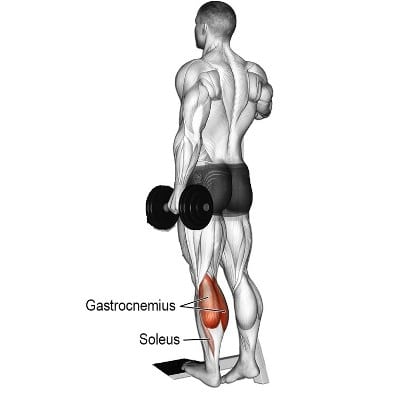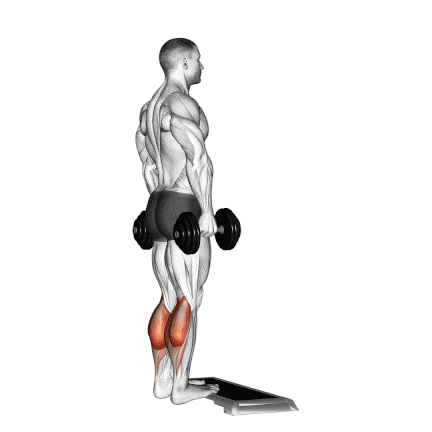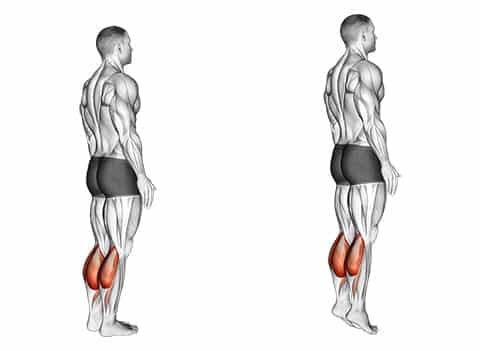The standing dumbbell calf raise is a good exercise for those who don’t have access to a calf raise machine or Smith machine.
You can do this exercise right at home or anywhere you like without a machine.
However, many people don’t train their calves enough and have weak, underdeveloped lower legs.
That’s why we’ve put together the ultimate guide to dumbbell calf raises: to help you improve your lower leg strength.
Want to take your gains to the next level? Discover your daily calorie needs with our free TDEE calculator

Standing Dumbbell Calf Raise Muscles Worked
When performing dumbbell calf raises, several muscles are worked primarily in the lower leg.
The main muscles targeted during calf raises include:
- Gastrocnemius
- Soleus
- Plantaris
- Tibialis anterior and posterior
Standing calf raises mainly focus on the gastrocnemius, while sitting raises mainly target the soleus.
In a study by Nunes et al. (2020), researchers examined the effects of different foot positions during calf training on muscle growth.
- They found that positioning the foot outward (FPO) led to greater increases in the medial gastrocnemius head,
- Pointing the foot inward (FPI) resulted in greater gains for the lateral gastrocnemius head.

How To Do Standing Dumbbell Calf Raise
- Hold a dumbbell in each hand. Stand up straight on the stepper with your feet facing forward and placed hip-width apart.
- Keep a slight bend in your knee and hold your hands by your side.
- Raise your heels by pressing the balls of your feet into the ground.
- You should move your body upwards until you’re standing on your toes.
- Hold this position, and slowly lower your heels back to the ground.

Tips and Forms
- Start with lighter dumbbells and increase the weight as you get stronger and more comfortable.
- Avoiding any sudden jerking or bouncing movements.
- Don’t rely on the momentum of your movements; use your calf muscles to lift your body up.
- When you lower your heels, inhale deeply and exhale deeply when you raise them.
- Control the movement and avoid using momentum to lift your heel.
- Pause and squeeze for a count of 1-2 at the movement’s top for added intensity.
- Beginners: Start with 4–6 sets per week.
- Most intermediate-advanced lifters require a minimum of 8 sets of direct calf work per week to make noticeable gains.
- To target the slow twitch fibers in your calves and promote growth, focus on higher rep ranges of 15-30 reps per set.
- Also, do a smaller number of weekly workouts (around 1-2) that include lower rep ranges of 6-12 reps to give you more variety and work different muscle fibers.
Standing Dumbbell Calf Raises Variations
There are several ways to do standing dumbbell calf raises, depending on your fitness level.
- A few modifications can make the dumbbell calf raise easier. One way to counter this problem is to do chair-supported or floor calf raises.
- You can do single-leg calf raises if you want a more advanced variation of the dumbbell calf raise.
- You could also make it more challenging by using heavy dumbbells.
1. Dumbbell Floor Calf Raise
It is done on the floor instead of a raised surface, such as a weight plate or aerobic step. The flat foot position places less stress on your ankles and knees compared to exercises where your heels come off the floor.
This makes it a great option for those with joint limitations or mobility limitations.

How To Do
- Stand with your feet shoulder-width apart on the floor and hold a dumbbell in each hand.
- Push your heels up as high as you can.
- Hold the contracted position briefly and squeeze your calf muscles.
- Slowly lower your heels back down to the starting position.
Know More: Dumbbell Leg Exercises To Mass And Strength
2. Single Leg Dumbbell Floor Calf Raise
The single-leg dumbbell floor calf raise is harder than regular calf raises.
Standing on one leg during the raise strengthens your core and ankle stabilizers more than standing on two legs. This improves overall balance and coordination.

How To Do
- Stand on a flat surface with your feet hip-width apart, and hold a dumbbell in one hand.
- Lift one foot off the ground while maintaining balance on the other foot.
- Push your heel up as high as you can.
- Squeeze your calf muscle to hold the contracted position for a second.
- Slowly lower your heel back down to the starting position.
- Switch legs and repeat the exercise with the other leg.
3. Standing One Leg Dumbbell Calf Raise
The single-leg variation makes the calf raise harder, which makes your calf muscles work harder and makes you stronger.
The elevated position of your heels will allow for a deeper stretch at the bottom of the movement.

How To Do
- Hold a dumbbell by your side, in your left hand, and hold it with your left hand.
- With your left foot, stand on a platform, with the arch and heel of your foot suspending off.
- Grasp something with your right hand for stability.
- Exhale as you raise your heel by extending your ankle.
- Hold for a count, and then slowly reverse the motion and lower your heel until you feel a mild stretch in your calf.
- Hold for a count of one. Repeat for more repetitions.
- Now repeat with your right leg.
Know More: Bodyweight Leg Exercises for Mass, Strength and Power
Takeaways
Calf training is often overlooked but essential to any well-rounded workout routine.
To make a dumbbell calf raise more challenging, you could try a single-legged calf raise, or you could increase the weight.
Strong calf muscles can improve balance, stability, and athletic performance, giving you a toned, defined look.
References
- Ema R, Ohki S, Takayama H, Kobayashi Y, Akagi R. Effect of calf-raise training on rapid force production and balance ability in elderly men. J Appl Physiol (1985). 2017 Aug 1;123(2):424-433.
- Vissing, K., Brink, M., Lønbro, S. et al. Muscle Adaptations to Plyometric vs. Resistance Training in Untrained Young Men. Journal of Strength and Conditioning Research.

Manish brings over 10 years of hands-on experience in weight lifting and fat loss to fitness coaching. He specializes in gym-based training and has a lot of knowledge about exercise, lifting technique, biomechanics, and more.
Through “Fit Life Regime,” he generously shares the insights he’s gained over a decade in the field. His goal is to equip others with the knowledge to start their own fitness journey.
